Nick Walkley, PhD Fellow, Oslo School of Architecture & Design
Skrevet av: Nick Walkley
Publisert: 11. desember 2023
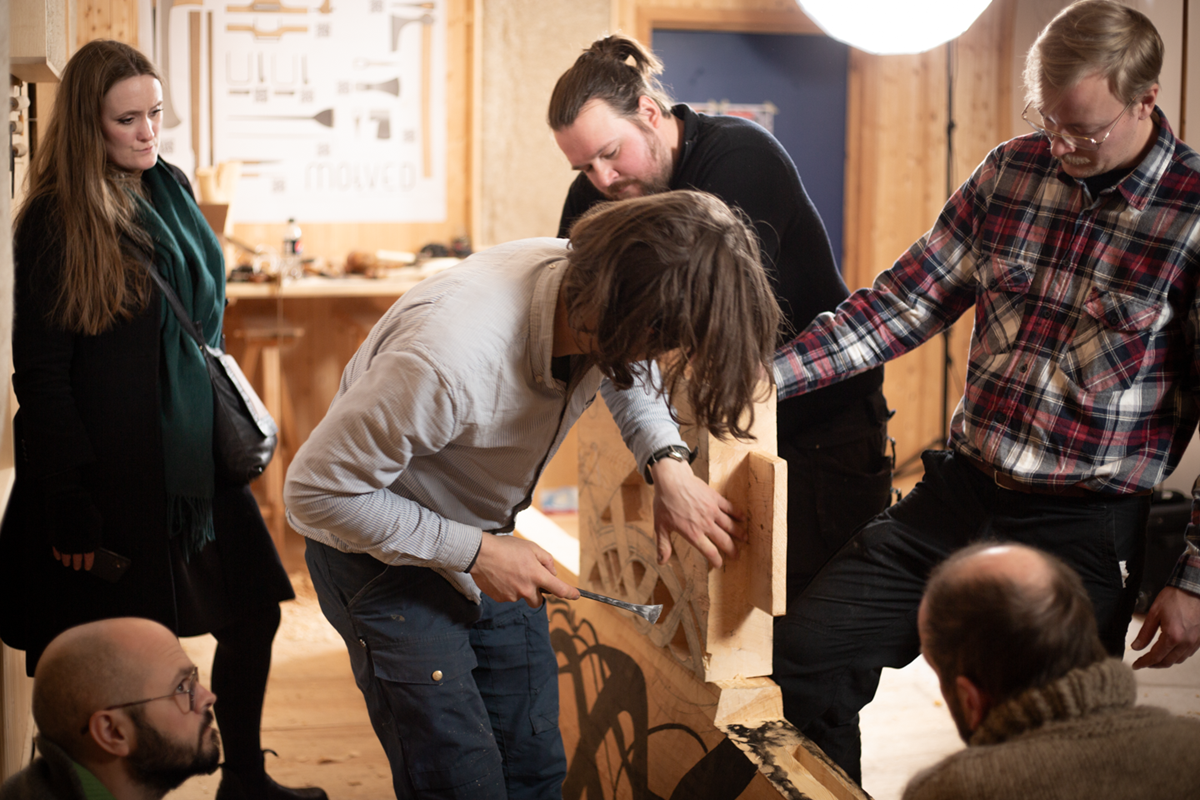
The Treets Mester project group assembled, led by project manager Linn Willetts Borgen. Photo: Nick Walkley
Of all the art and architectural historians to write about Urnes Stave church, none have been afforded the insight of seeing it being put together. Yet, nine and a half centuries after it was first carved, that is exactly the process I was invited to witness taking place at Hjerleid School of Traditional Crafts. Between 4-6th December 2023, the Treets Mester project assembled here in Dovre for a seminar, hosted by woodcarvers Even Hansen and Njål Andreassen, and joined by Jon Anders Fløistad, August Horn, Kai Johansen, blacksmith Pål Lien, project manager Linn Willetts Borgen, and archaeologist Bo Alexander Granbo. Temperatures outside reached -30°C during the week, so thick knitted jumpers were unanimously the clothing of choice as the three teams met, where for the first time they were bringing two of the three planks together. With the portal design painted onto the planks and the carving work underway, this meeting was a visually historic one, showing the first glimpses of the portal as it now begins to take form.
As an invited guest, I was contributing some of the findings of my ongoing PhD research project to the discussion, one running parallel also with the portal in focus. It studies the building’s historiography and reception history, studying the many reproductions, copies and imitations of the Urnes Stave Church that have all contributed to its growth into a modern monument over the past two centuries. Written from the architect’s perspective, it also aims to extend that history with a digitally produced reconstruction of the western façade of the Urnes Style Church, of which the portal was once a centrepiece. Like the Treets Mester project, it expands the growth of the monument through its reproduction with a knowledge-based contribution. Despite our different technological approaches, we have much to discuss at Hjerleid. We all share a passion for this complex artwork and the exploration of its hidden mysteries. The projects also have a complementary overlap: Whilst the craftsmen here focus on how the portal was constructed, my work will question more why, exploring more the nature of the context that the portal once belonged to. Here I share my observations from Hjerleid as an anthropological study, in a triptych of ‘stories’, or details, which serve to illustrate the nature and importance of the knowledge arising from the Treets Mester project.
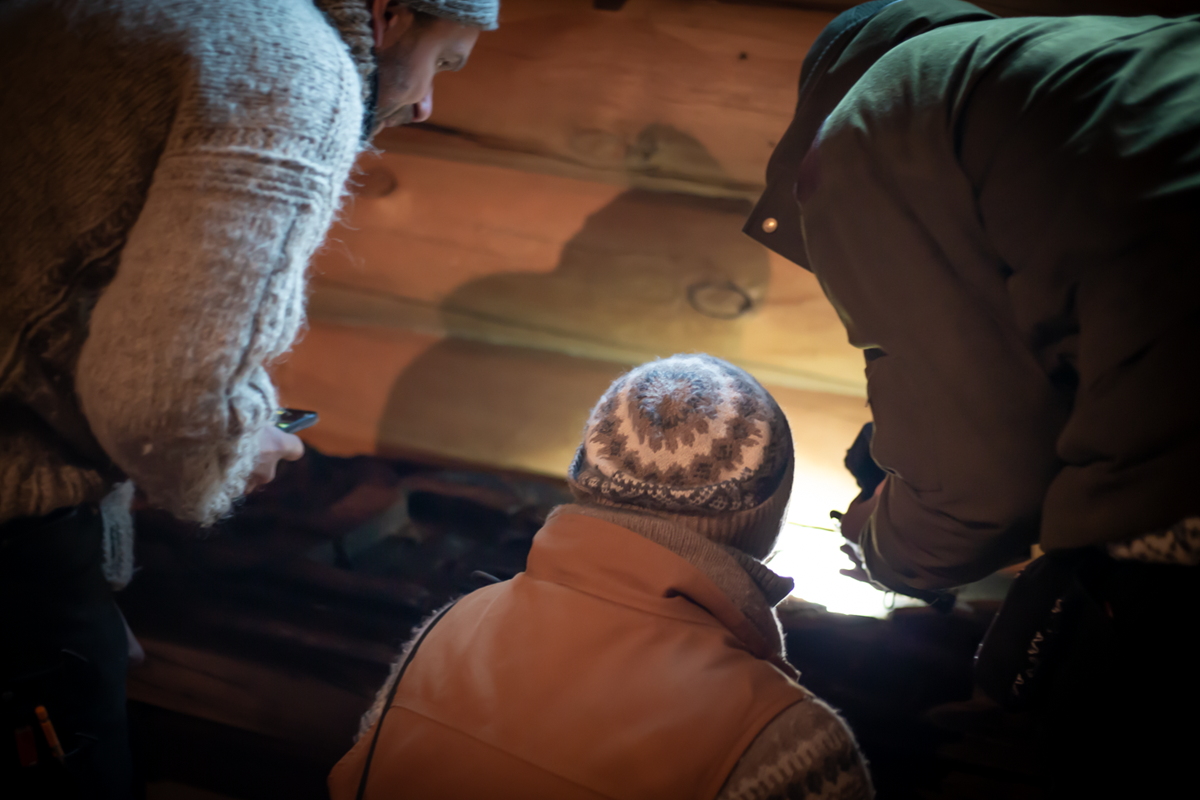
Kai Johansen, Even Hansen and August Horn inspect the Bjølstad Portal. Photo: Nick Walkley
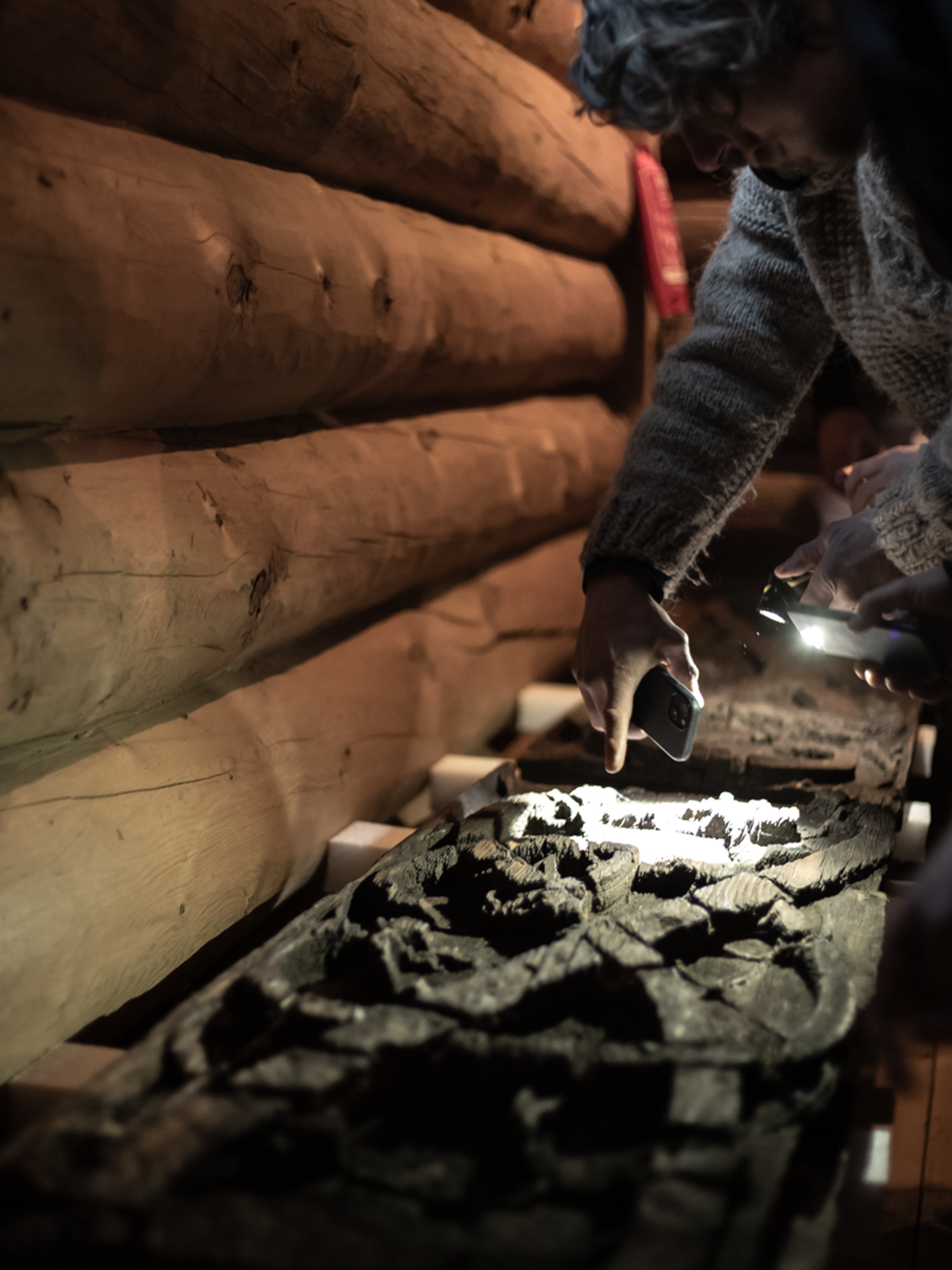
Kai Johansen and Jon Anders Fløistad discuss tool markings on the Bjølstad Portal. Photo: Nick Walkley
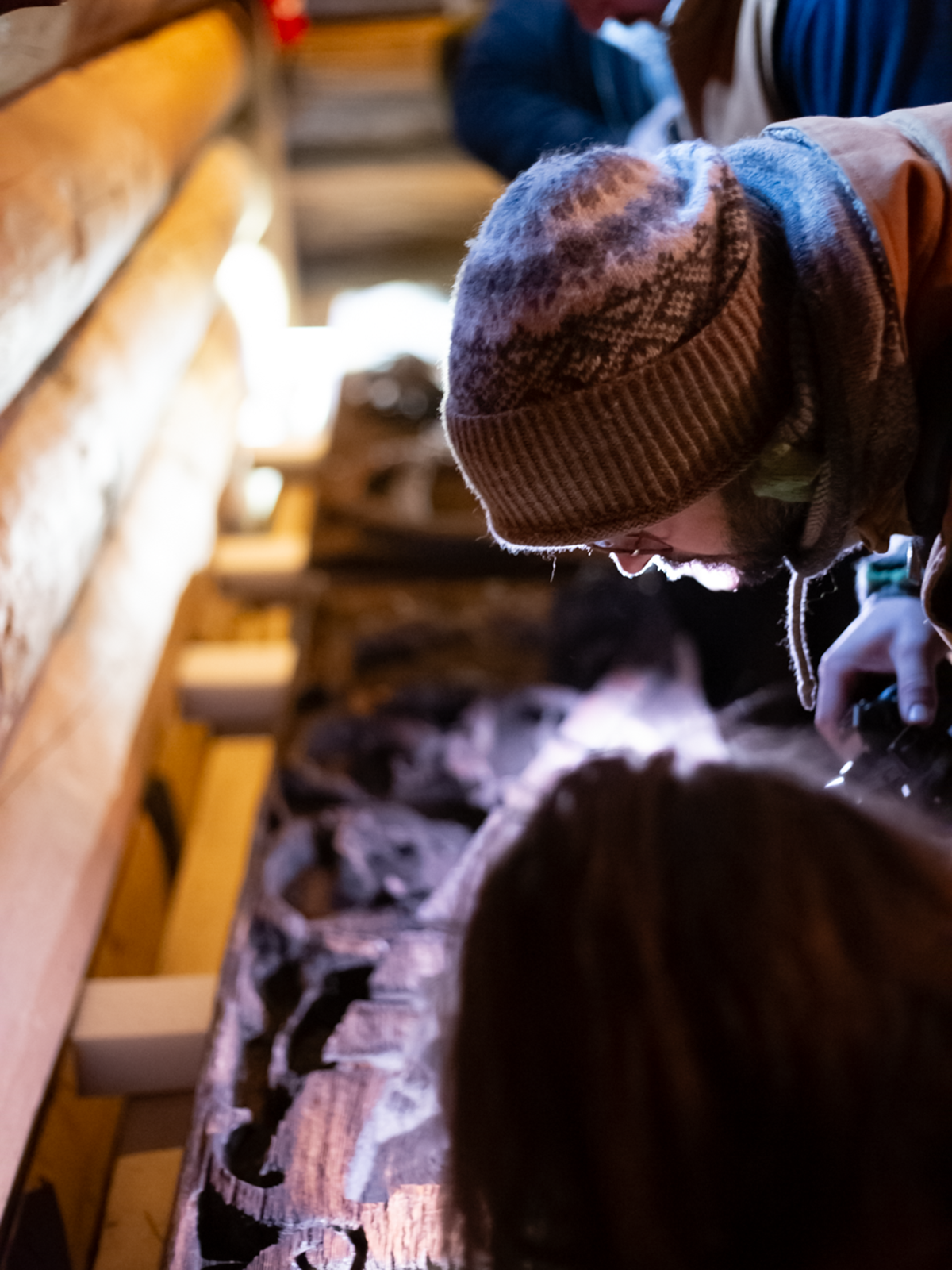
Even Hansen inspecting the Bjølstad Portal. Photo: Nick Walkley
Until now, the craftsman’s perspective has been almost entirely absent from published studies on the Urnes Portal. Before the Treets Mester project, those with the skill to carve such an object have had little opportunity to contribute to that discussion. Yet, woodcarvers see things that art historians simply do not. The opportunity on this seminar to examine the Bjølstad portal was an example of how the craftsman’s eye is trained differently. On day two of the seminar, the group travelled to Heidal Church, and were welcomed into the chapel where the portal had been temporarily demounted from its entrance and stored inside in preparation for a dating analysis.
On entering the chapel, all five wood carvers went straight to the bench to view the portal at close proximity, shining torchlight across the surfaces and examining the wood for tool marks. To their delight, there were many more than are visible at Urnes, on a portal in a similar style and so far thought to date from a similar period. In contrast, my architect-historian’s instinct was to view the pieces from distance, taking in their overall design. At closer proximity, I was pleasantly surprised by the richness of detail, which had never been conveyed by the small images printed in books. But as with earlier historians, I remained frustrated by their fragmented nature and the lack of a more indicative picture of the building they must have belonged to.
The craftsmen found the carvings of great interest and were able to read its tool markings that indicates how they were made. This is information best understood by those with the specific tacit knowledge that only years of experience of carving can develop. It is also best conveyed by the craftsmen themselves and must be told by them. This is why their input through this project into a discourse dominated by art-historical or archaeological perspectives is extremely valuable. A dendrochronological dating would reveal this portal’s relation to Urnes, to which the craftman’s perspective on its methods of production will also be an important point of comparison.
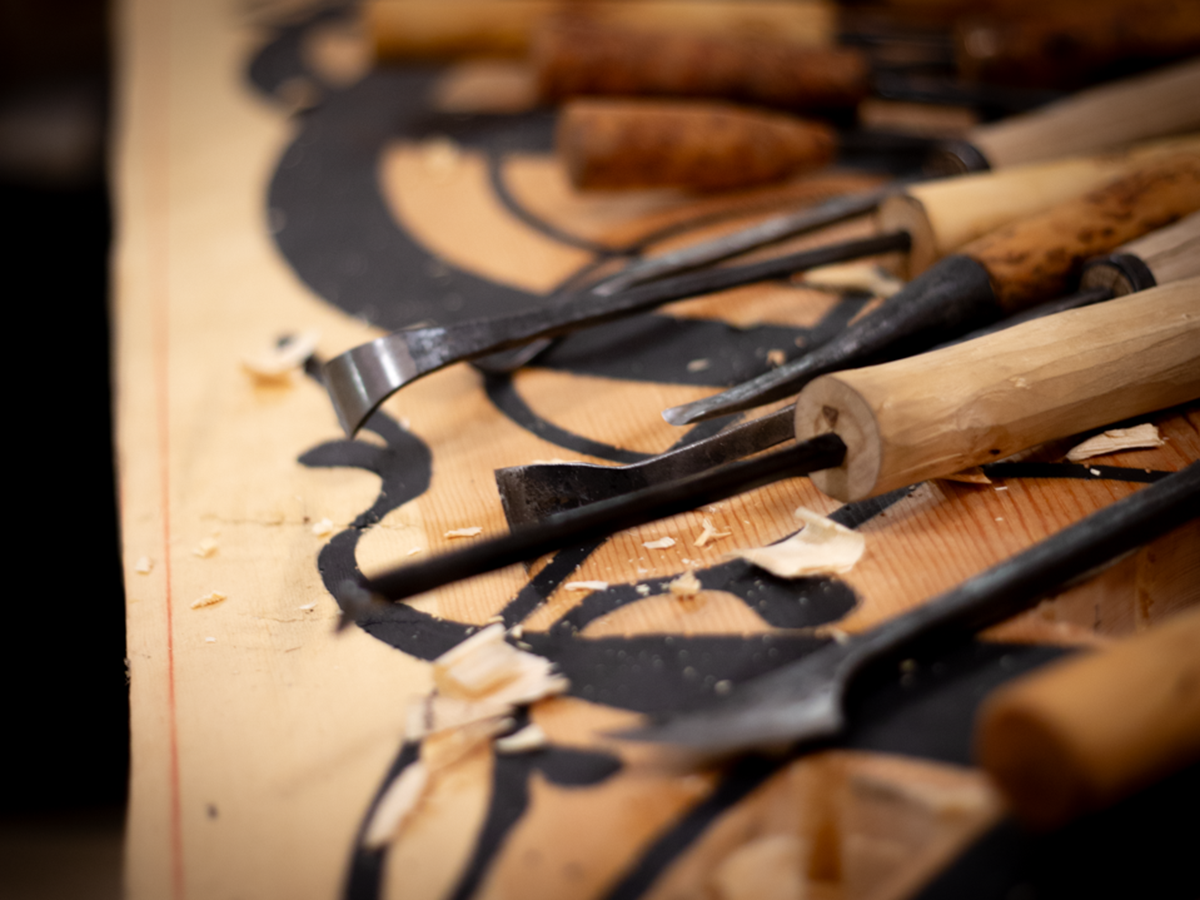
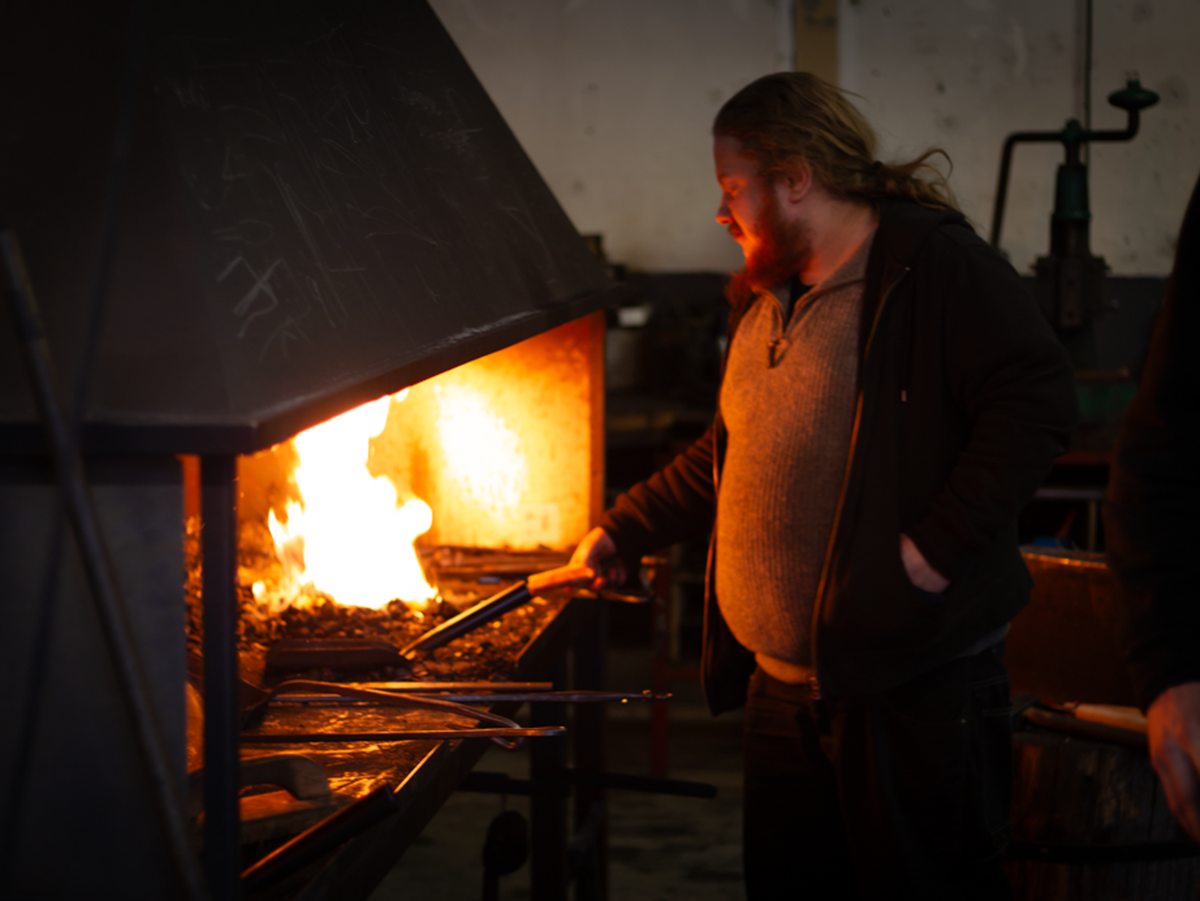
Pål Lien heats the woodcarving tool for alterations. Photo: Nick Walkley
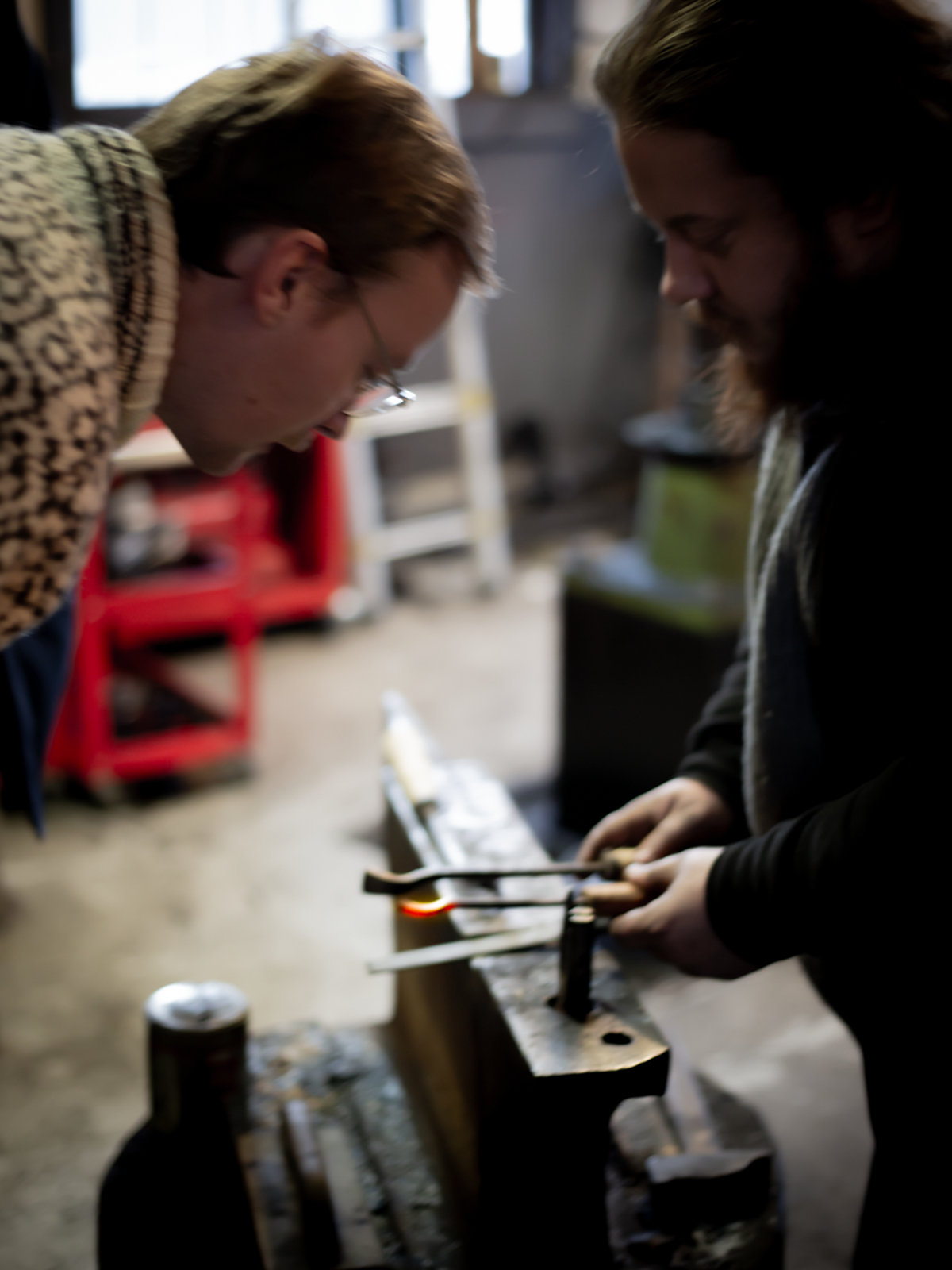
Pål Lien and August Horn discussing the reshaping of tools. Photo: Nick Walkley
At this stage, the unique tool set developed to produce the Urnes portal is now well-tested. A near-forensic analysis of the marks left behind, and the direction and pressure evidently used to make them are clues to the type of tools that were used to make it. So too are the forms and curvatures of the carvings themselves, which each team is now attempting to recreate. Whilst the project adopts a ‘processually authentic’ approach to copy the portal, it seems so far that this process is in fact being done in reverse. The tool set, and these blog entries from the craftsmen documenting their usage, are the products of this knowledge that reverses the process working back from the portal. In the end, though the copy of the portal will be a fascinating object, the production of knowledge around the processes that made it will perhaps be a greater contribution than the copied portal itself.
Whilst based at Hjerleid, the team had the opportunity to visit blacksmith Pål Lien at his workshop in nearby Kvam, where the tool set for the project has been forged. Much of the discussion at the seminar centred around the tools, and how those were working in the early stages of carving. Some required improvement it was decided, and here was the opportunity to make some minor adjustments, to thrust them back into the heat of the fire, making their iron forms more fluid so their shape could be altered – woodcarver in dialogue with blacksmith – then to resharpen, retest and refine the blade and its overall effectiveness. We cannot know if the toolset was uniquely produced to carve the Urnes Portal in 1070 AD, and what level of tool customisation those workers had available to them. But it can be assumed that what they had to carve that portal closely resembled those forged in Kvam in 2023, those which are now in use by the Treets Mester project.
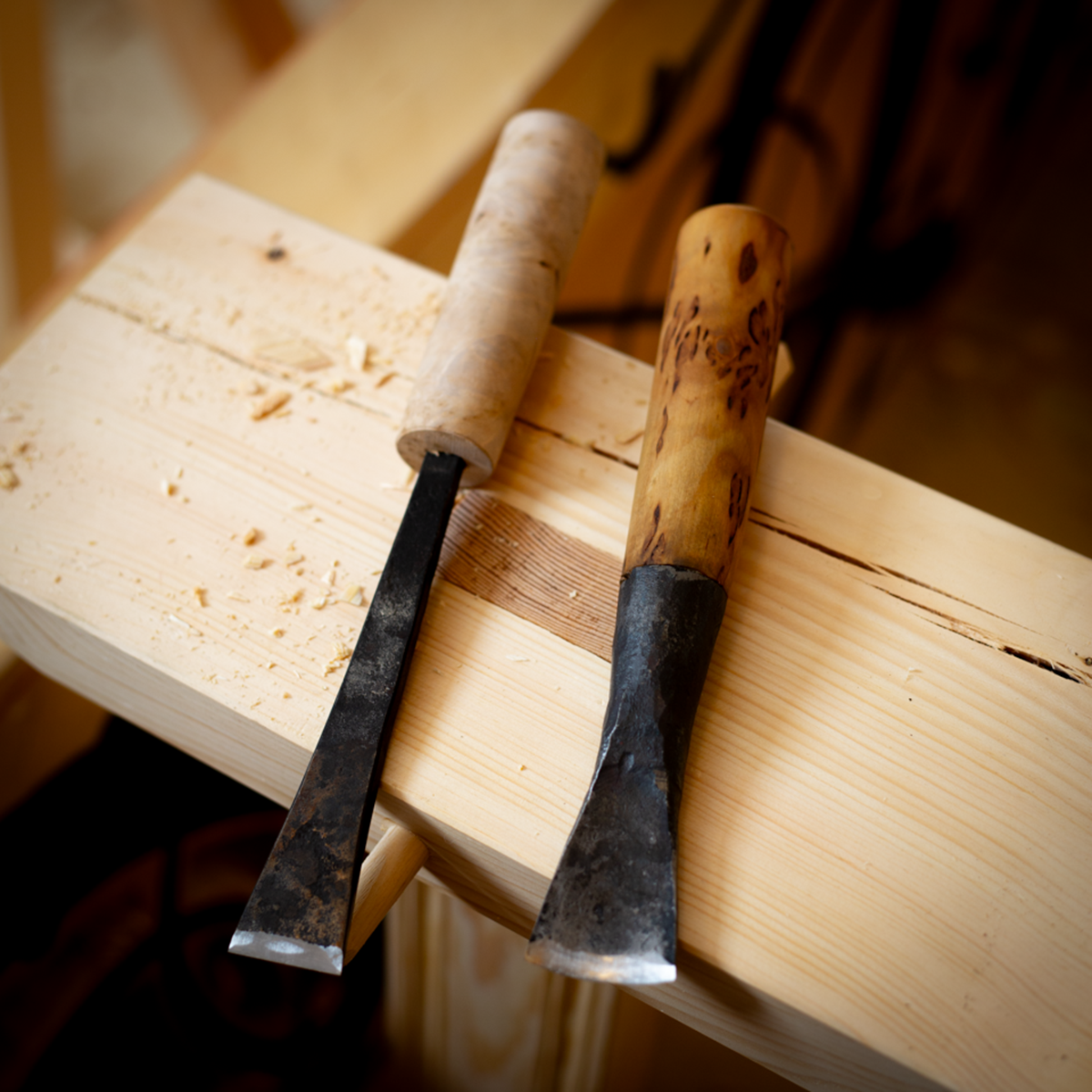

Jon Anders Fløistad, Kai Johansen, August Horn and Njål Andreassen discuss the joining of the two planks. Photo: Nick Walkley
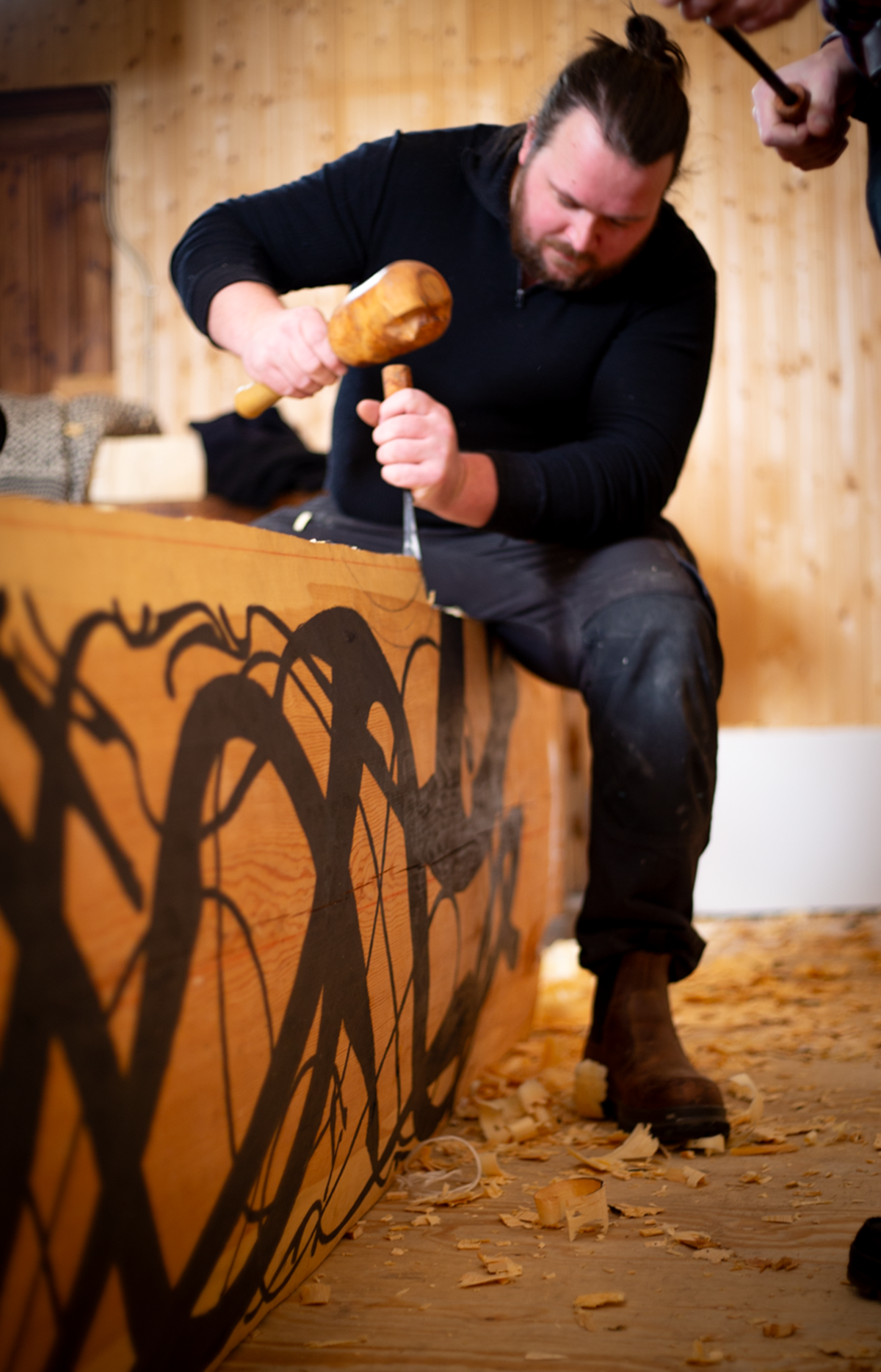
Njål Andreassen prepares the join on the right portal plank. Photo: Nick Walkley
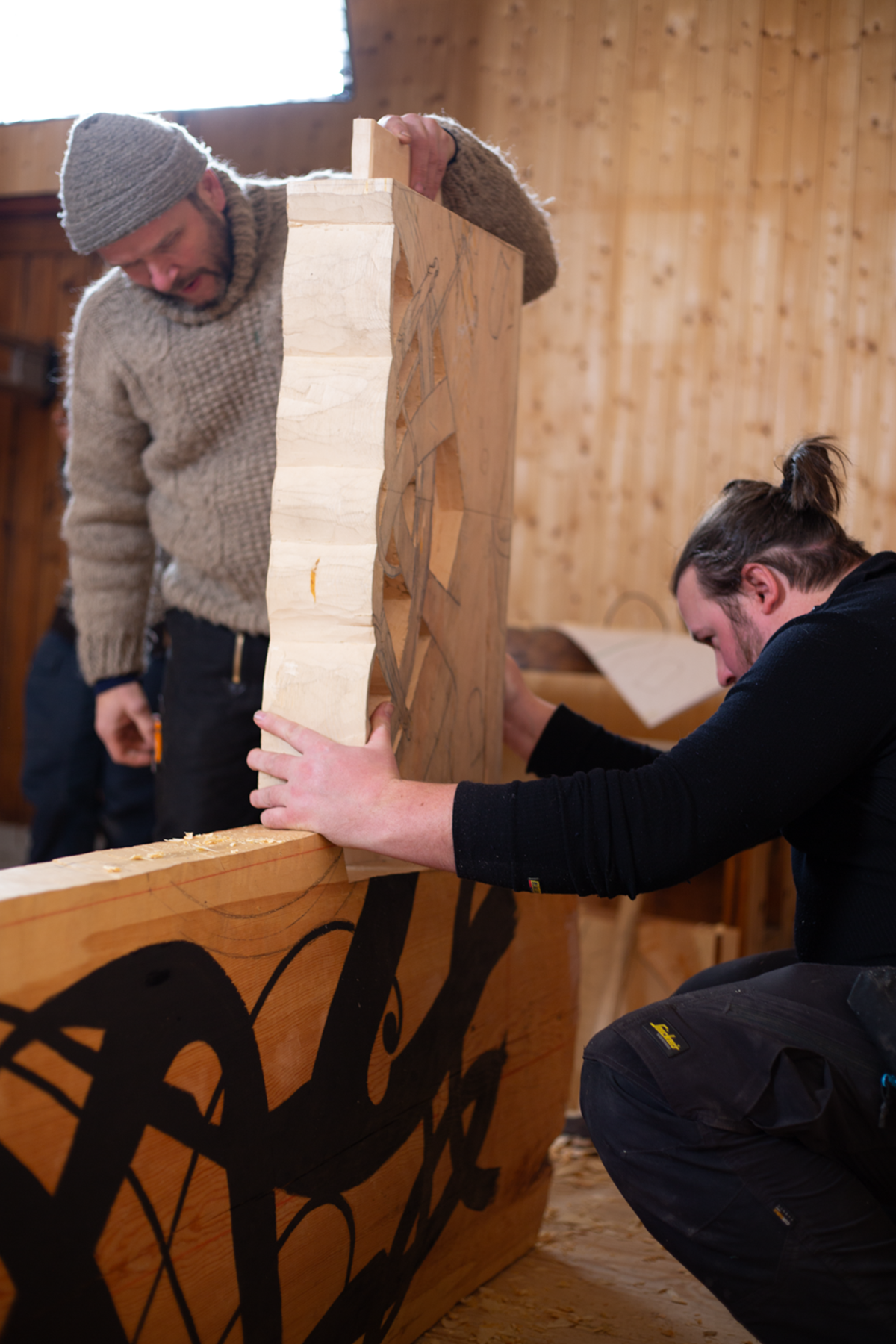
Kai Johansen and Njål Andreassen making the first join. Photo: Nick Walkley
The right portal plank lies horizontally in the basement workshop at Hjerleid. It is just over 2 metres long, over half a metre wide, and around 15 cm thick. Kai and Njål, both conditioned to lifting heavy loads, carefully managed its considerable weight to manoeuvre it into position ready for working. The final morning of the seminar will be spent forming the join between Kai’s top mid-piece and Even and Njål’s right plank. It is now we are beginning to appreciate a sense of scale, of the sense of effort that was once required to assemble this portal. As the doorway within the western facade of the ‘Urnes Style Church’, the current Urnes church’s predecessor, these were only 2 of 11 vertical architectural elements, 6 of those likely deeply carved, with a low relief door leaf and a similar gable carving crowning them. The original planks were longer still, today’s portal having been cropped in length to fit its new location within the 1130s building. Each one of them would have had a considerable size and weight, the handling of which is not easy to appreciate from the position they have occupied for 900 years in the north wall of the stave church.
Seeing the coordinated effort just to align two pieces here in the basement suggests that nothing about the original building was formed by chance. The human energy required to fell such large timbers, retrieve the material from the forest, bring it to the site and erect into this construction indicate the entire operation was a meticulously planned and coordinated team effort. Additionally, there is the carved ornamentation, exquisitely designed, compositionally balanced but asymmetrical, with well-proportioned beasts entangled in a perfect adherence to their rule of strictly woven interlace. Carving out the vast amount of material between each of the beasts is also proving to be a time-consuming task. According to August Horn, simply ‘bottoming out’ one of the negative spaces between the beasts takes on average around an hour for each (see here for Even’s fast motion film of that process). There are around 30-40 of those spaces on each plank. From their observations at Urnes during the summer, August and colleague Jon-Anders noted that the quality of the craftsmanship on the two outer planks seemed to be less than of the portal planks. It seems that there must have been some logical organisation and delegation of the workload within a team, perhaps between master and apprentice – between planks, or of work phases. However that was achieved, observing all of this work being actioned again by three separate teams in 2023 creates an appreciation for the complexity of the original process, and the level of planning required to realise their overall vision.
In our discussions, a concern was raised that uncovering the mysteries of this artwork through this project would somehow diminish its intrigue. I would argue the opposite. Through the work being done as part of Treets Mester, the project is uncovering a yet greater level of mystery. It is revealing the deeper level of appreciation deserved for the efforts and skill of those who first built the Urnes Style church in 1070 AD, and the sophistication of the society that erected it and its portal. As the project edges towards a better understanding of how it was done, there are still many unsolved mysteries as to what impulses formed it, to what cultural networks it belonged, and to why such a building came to exist. This copy of the Urnes Portal will allow us to stand yet ever closer to its literal and metaphorical threshold, and will only thereby intensify our encounters with the mystery that surrounds it.
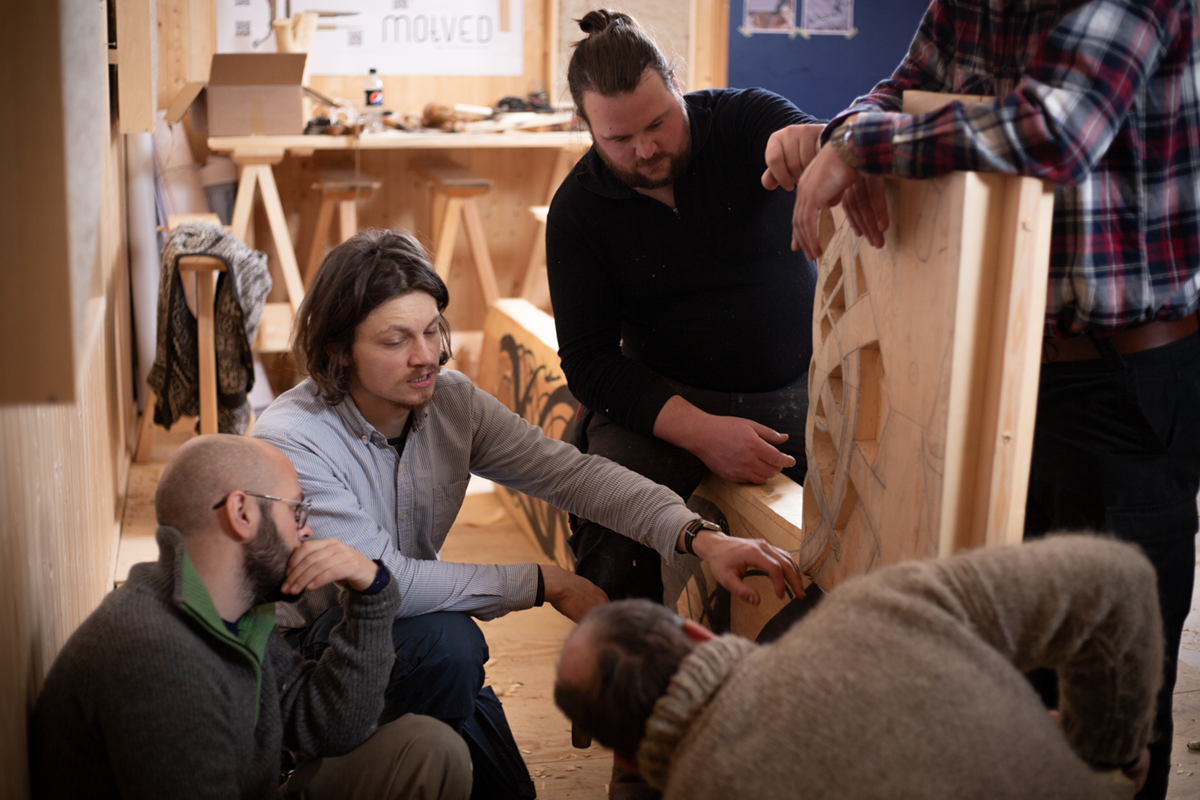
Even Hansen, Jon Anders Fløistad, Njål Andreassen, Kai Johansen and August Horn inspect the first joining of the mid and right portal planks. Photo: Nick Walkley
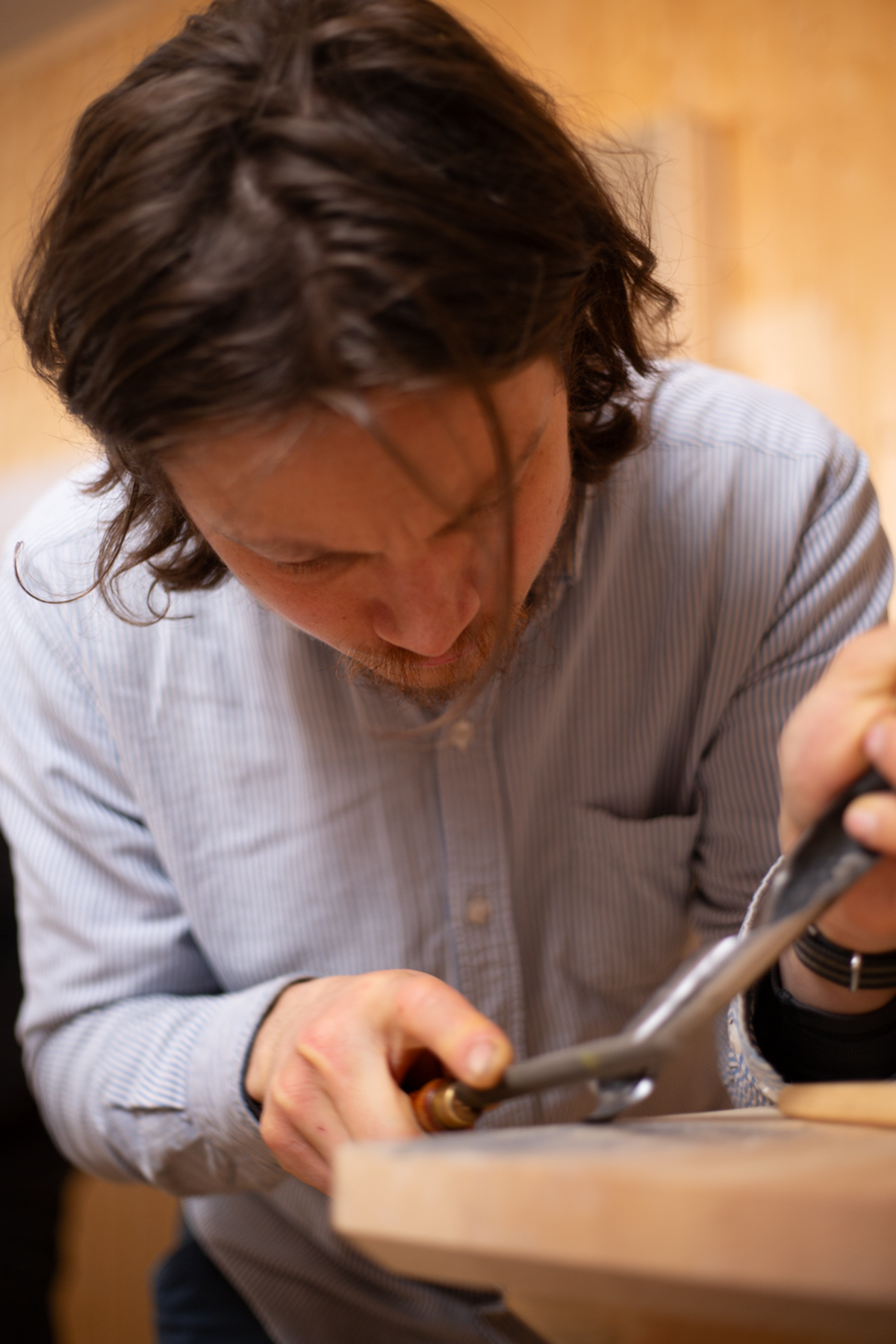
Jon Anders Fløistad preparing and sharpening a work tool. Photo: Nick Walkley